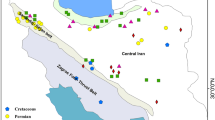Abstract
The Kamoto deposit consists of two stratiform orebodies separated by a barren sedimentary unit. It is a copper and cobalt deposit, the main features of which are summarized in the first part of the paper. Above the upper orebody, dolostone beds are found, where pyrite is the only sulfide mineral. This pyrite was investigated with the help of a microprobe: all idiomorphic grains were found to be surrounded by a well-defined rim, where the cobalt content reaches 4%; framboidal grains were also found to be heterogeneous with respect to cobalt. The distribution of nickel and copper is described. These observations afford one more evidence that post-depositional events played an important role in the “Mine Series” of Katanga, especially with regard to heavy metals geochemistry.
Resume
Le gisement de Kamoto est constitué de deux corps minéralisés stratiformes séparés par une unité sédimentaire stérile. C'est un gisement de cuivre et de cobalt dont les principales caractéristiques sont brièvement résumées. Audessus du corps minéralisé supérieur, on trouve des couches de dolomie, où la pyrite est le seul sulfure présent. Cette pyrite a été étudiée à l'aide d'une microsonde: tous les grains idiomorphes y sont entourés d'une bordure bien nette, où la teneur en cobalt atteint 4%; les grains d'apparence framboïdale sont également hétérogènes au point de vue de leur teneur en cobalt. La distribution du nickel et du cuivre est décrite. Ces observations apportent um témoignage supplémentaire de l'importance des événements postérieurs au dépôt dans la «Série des Mines» katangaise, tout spécialement en ce qui concerne la géochimie des métaux lourds. Elles démontrent que le «système» constitué par la roche sédimentaire est resté ouvert pendant un certain temps après la sédimentation.
Similar content being viewed by others
References
Amstutz, G. C., Park, W. Ch.: The paragenetic sequence of sulfides in the diagenetic crystallization sequence. Symposium on stratabound sulfide ore deposits, IMA-IAGOD Meetings, Tokyo, Japan (1970).
— Bubenicek, L.: Diagenesis in sedimentary mineral deposits. In: Developments in sedimentology 8. Diagenesis in sediments, p. 417–475. Larsen, G. and Chilingar, G. V., ed. Amsterdam: Elsevier (1967).
Bartholome, P.: Les minerais cupro-cobaltifères de Kamoto (Katanga-Ouest) I. Petrographie. Studia Universitatis “Lovanium”, Faculté des Sciences, Kinshasa 14, 1–40 (1962).
-- Kamoto (Katanga) et White Pine (Michigan): deux gisements stratiformes de cuivre. Acad. Roy. Sciences Outre-Mer, Bull. des Séances, 397–410 (1969).
Barton, P. B., Skinner, B. J.: Sulfide mineral stabilities. In: Geochemistry of hydrothermal ore deposits, p. 236–333. H. L. Barnes, ed., New York: Holt, Rinehart and Winston, inc. (1967).
Berner, R. A.: Iron sulfides formed from aqueous solution at low temperatures and atmospheric pressure. Journ. Geol. 72, 293–306 (1964).
— Sedimentary pyrite formation. Amer. Jour. Sci. 268, 1–23 (1970).
Brown, Alex-C.: Zoning in the White Pine copper deposit, Ontonagon County, Michigan. Ph. D. Thesis, University of Michigan (1968).
Darnley, A. G.: Petrology of some Rhodesian copperbelt orebodies and associated rocks. Bull. Inst. Min. Met. London 638, 137–173 (1960).
— Sulfur isotopes of some Central African sulfide deposits. Econ. Geol. 61, 409–414 (1966).
de Bethune, P., Goossens, P., Berger, P.: Emploi des grenats zonaires comme indicateurs du degré de métamorphisme. C. R. Acad. Sc. Paris 260, 6946–6949 (1965).
Demesmaecker, G., Francois, A., Oosterbosch, R.: La tectonique des gisements cuprifères stratiformes du Katanga. In: Gisements stratiformes du cuivre en Afrique, Symposium édité par J. Lombard et P. Nicolini, 2e partie, p. 47–115; Paris: Association des Services géologiques africains (1963).
Demirsoy, S.: Untersuchungen über den Einfluß der chemischen Zusammensetzung auf die spektralen Reflexionsfunktionen und Mikroeindruckhärten im System FeS2-NiS2-CoS2, an Zonen eines natürlichen Bravorit-Kristalls. N. Jb. Miner. Mh., 323–333 (1969).
El Baz, F., Amstutz, G. C.: A statistical study of bravoite zoning. Mineral. Soc. Amer. Special Paper 1, 190–197 (1963).
Hollister, L. S.: Garnet zoning: an interpretation based on the Rayleigh fractionation model. Science 154, 1647–1651 (1966).
Kalliokoski, J., Cathles, L.: Morphology, mode of formation, and diagenetic changes in framboids. Bull. Geol. Finland 41, 125–133 (1969).
Katekesha, F.: Le corps minéralisé supérieur de Kamoto. Liège Univ., unpubl. thesis, 1–60 (1970).
Klemm, D. D.: Untersuchungen über die Mischkristallbildung im Dreieckdiagramm FeS2-CoS2-NiS2 und ihre Beziehungen zum Aufbau der natürlichen „Bravoite“. N. Jb. Miner. Mh. 76–91 (1962).
Love, L. G., Amstutz, G. C.: Review of microscopic pyrite. Fortschr. Miner. 43, 273–309 (1966).
Ngongo, R. M.: Le corps minéralisé inférieur de Kamoto (Katanga, R. D. C.). Liège Univ., unpubl. thesis, 1–62 (1970).
Oosterbosch, R.: Les minéralisations dans le système de Roan au Katanga. In: Gisements stratiformes de cuivre en Afrique. Symposium édité par J. Lombard et P. Nicolini, lère partie, 71–136; Paris: Association des Services géologiques africains (1962).
Pirmolin, J.: Inclusions fluides dans la dolomite du gisement stratiforme de Kamoto (Katanga occidental). Ann. Soc. Géol. Belgique 93, 193–202 (1970).
Riley, J. F.: An intermediate member of the binary system FeS2 (pyrite)—CoS2 (cattierite). Amer. Min. 50, 1083–1086 (1965).
— The cobaltiferous pyrite series. Amer. Min 53, 293–295 (1968).
Robie, R. A., Waldbaum, D. R.: Thermodynamic properties of minerals and related substances at 298.15°K (25.0°C) and one atmosphere (1.013 bars) pressure and at higher temperatures. U. S. Geol. Survey Bull. 1259, 256 (1968).
Springer, G., Schachner-Korn, D., Long, J. V. P.: Metastable solid solution relations in the system FeS2-CoS2-NiS2. Econ. Geol. 59, 475–491 (1964).
Straumanis, M. E., Amstutz, G. C., Chan, S.: Synthesis and X-ray investigations within the system FeS2-CoS2. N. Jb. Miner. Abh. 101, 127–141 (1964).
White, W. S., Wright, J. C.: Sulfide-mineral zoning in the basal Nonesuch shale, Northern Michigan. Econ. Geol. 61, 1171–1190 (1966).
Wyllie, R. J. M.: Katanga copper-Gecomin's open pit mines achieve record production. World Mining, April, 36–40 (1970a).
-- Katanga copper mining goes underground, mechanized, and trackless at Kamoto. World Mining, May, 61–64 (1970b).
Author information
Authors and Affiliations
Rights and permissions
About this article
Cite this article
Bartholomé, P., Katekesha, F. & Ruiz, J.L. Cobalt zoning in microscopic pyrite from Kamoto, Republic of the Congo (Kinshasa). Mineral. Deposita 6, 167–176 (1971). https://doi.org/10.1007/BF00208027
Received:
Issue Date:
DOI: https://doi.org/10.1007/BF00208027




